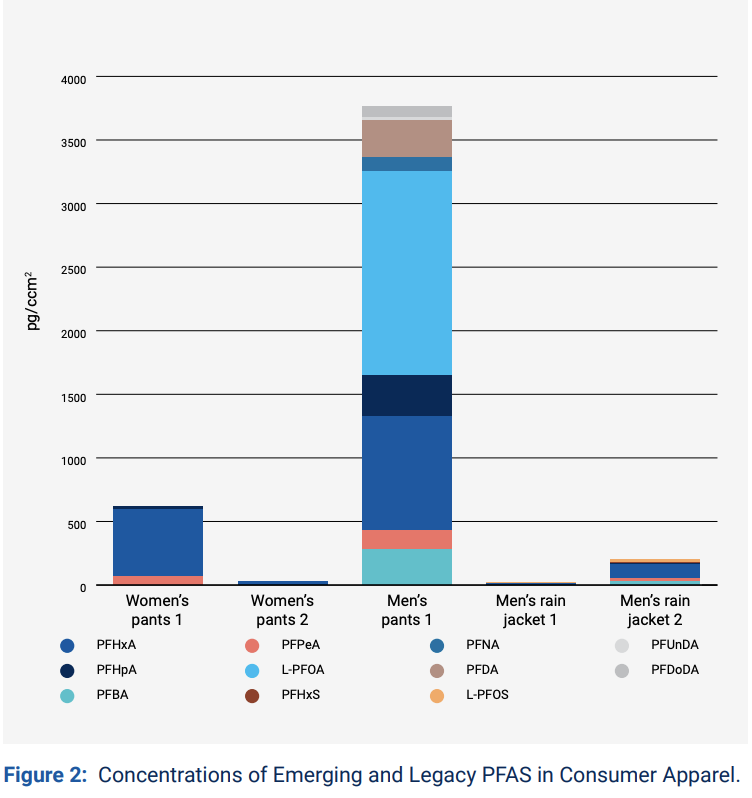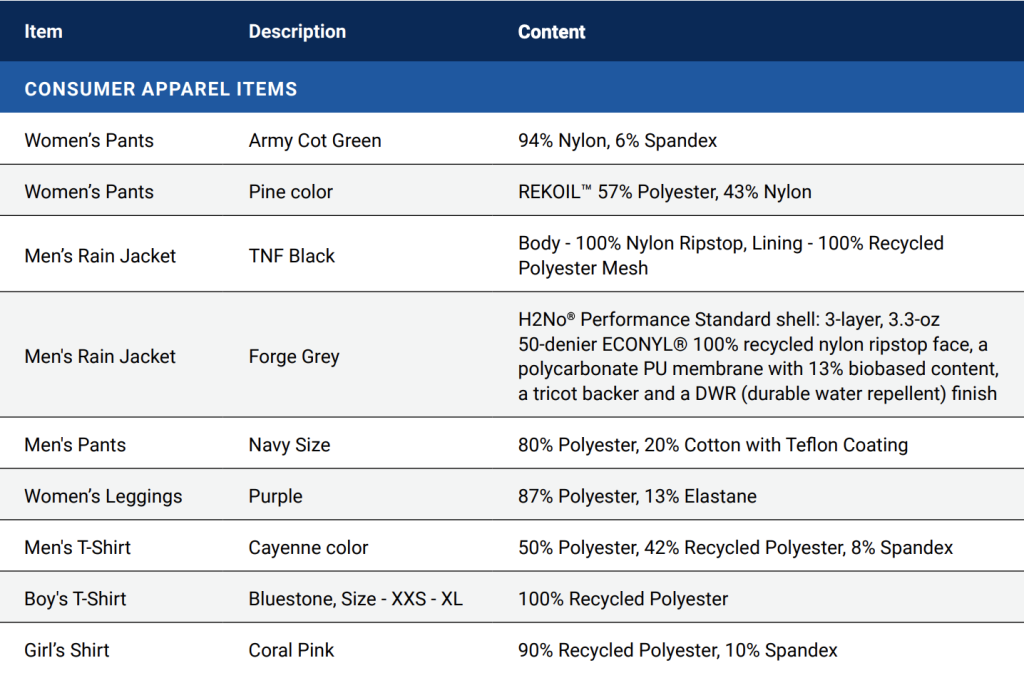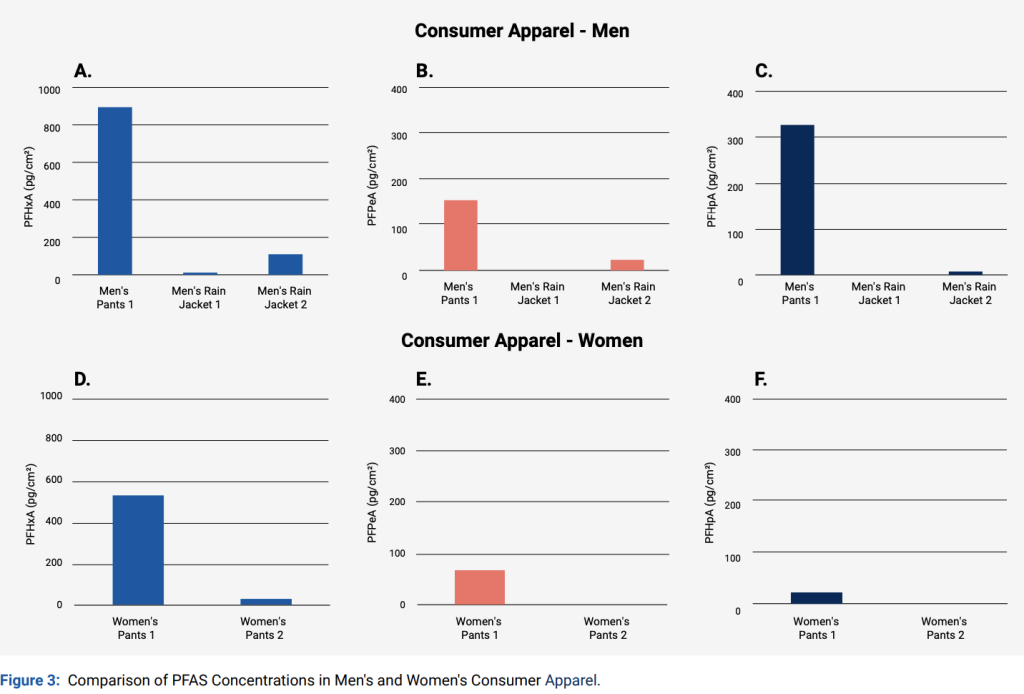Chemical Insights Research Institute (CIRI) of UL Research Institutes released its first report on a multi-phase research study of per- and polyfluoroalkyl substances (PFAS), commonly referred to as “forever chemicals,” associated with consumer and commercial textiles.
This ongoing study, conducted in partnership with the Rollins School of Public Health at Emory University, provides insights into the measurement of PFAS in various consumer textiles and how these PFAS enter the human body. Materials studied included consumer wearables and textile coverings for upholstered furniture.
“This research contributes to CIRI’s strategic goal of evaluating chemicals of concern used in our everyday products and how they can affect human health, including that of children,” said Dr. Marilyn Black, vice president and senior technical advisor, CIRI. “Some data suggest that fetal development and cognitive capacity of young children may be altered.”
SGB Media has been investigating the PFAS issue and the effect of legislation and new restrictions on their use around the world. The report is, for the most part, scientific and not written in layperson’s terms, but it is the first clear indication that SGB Media has found regarding the testing that is being done and what outcomes may be expected.
One observation the editors at SGB Media made was that governmental agencies, state legislatures, and the EPA may be attempting to create solutions and solve the PFAS problem without full knowledge of the actual issue or how it can be addressed. The report appears to suggest that the effort may be in the first inning of the effort to better understand the issue. Recommendations will come late.
In the interim, brands and manufacturers in the active lifestyle market have fast-tracked their solutions, reacting to some early restrictions laid out by some states and the EU that could significantly impact inventories, delivery windows and the performance of materials as expected.
Interestingly, the pattern of PFAS identified in the studied textiles did not fully align with those PFAS found in human blood, as recently reported by the U.S. Centers for Disease Control and Prevention; this could indicate a lag in biomonitoring about current market PFAS use.
Another interesting tidbit was that the researchers did not get similar readings for men’s and women’s products. PFHpA found in men’s pants was 13-fold higher than the levels detected in women’s pants. High concentrations of L-PFOA were found only in one brand of men’s pants and not in any other consumer apparel evaluated. A similar observation was made when assessing jackets.
So the question for those conducting these studies will be why are pants and jackets seen differently when it may be a brand or origin issue for the fabrics measured. Are they looking at standard nylon or polyester products? Windwear, DWR and WPB products in the same light? Or will they be taking it down to those levels in future studies to assess the risk for the consumer based on specific textile technologies?
In any case, the market and these researchers need to hear from the trade associations about the methods they are using so they may communicate effectively with the federal agencies and state entities that are putting companies at risk through new restrictions on use – without clearly understanding the end problem. Everyone, including all brands and manufacturers that spoke with SGB Media, want to do the right thing, and they are doing it sooner rather than later to avoid the risk of bad inventory, or lawsuits and fines, or both, down the road.
The concept cannot simply be that PFAS are bad so stop using all textiles under that umbrella. The market needs to understand the risk for everyone based on real science and research studies as soon as practicable. No one wants to be involved in the first lawsuit, and the brands and retailers believe they need to jettison the risk now, regardless of how a particular product may be viewed later.
An Overview
Consumer apparel items from various brands were evaluated, including women’s and men’s pants, rain jackets, leggings, and t-shirts. Specimens were prepared for composition analysis to identify and quantify legacy and emerging PFAS.
Findings for Consumer Apparel:
- Of the 20 PFAS analytically targeted, 11 were detected in the textiles studied.
- Per-fluoro hexanoic acid (PFHxA) was the most commonly detected PFAS across the consumer textiles evaluated.
- Levels of measured PFAS showed variability within a textile material, indicating its inhomogeneous presence.
- Specific PFAS identified. and their levels varied across consumer brands.
Analytical Methodology
Table 1 of the full report lists the target group of PFAS that were identified for analysis. The list contains 20 PFAS that include three carbons or more. In addition, branched and linear isomers of PFOS and PFOA were analyzed separately because of their chemical properties.
Sample Preparation
For each consumer apparel item, a 2×2 cm2 material was cut using clean shears, then measured, weighed, and placed into a test tube. The weight varied by textile due to differences in textile material. These weights were multiplied by the concentration of PFAS measured in the textiles expressed as nanograms of PFAS per gram of textile material. The resulting PFAS mass may then be divided by the sample surface area to display the textile PFAS concentration as nanograms of PFAS per cm2, as displayed in Equation 1 as follows:
Table 2: Consumer Items, Descriptions, and Content
Extraction and Mass Spectrometry Procedures
An isotopically labeled internal standard and 1 mL methanol were added to each tube and sonicated for 30 min. After sonication, the organic solution was collected, reduced to dryness in a Turbovap evaporator, then reconstituted in the initial online extraction mobile phase and placed in LC vials. The solutions were injected into the online solid-phase extraction (SPE) column for extraction and cleanup, then diverted to LC-MS/MS for separation and detection. Quantification was achieved using the “gold standard” isotope dilution calibration. Samples were analyzed in triplicate (individual textile samplings) to determine the heterogeneity of the textiles. The method limits of quantification (LOQs), accuracy (based upon NIST SRM 2585 in dust materials), and relative standard deviations (RSDs) are shown in the full report. Data are reported as ng/g, which is corrected for mass use. The SRM in dust was used because it was the only non-biological NIST sample with PFAS measurements available. The concentrations detected in ng/g are converted to pg/cm2 2 using Equation 1 as outlined in the full report.
Results – Consumer Apparel
PFAS concentration determined in each of the consumer apparel items are shown in Figure 2. Of the 20 PFAS measured, only 11 PFAS were detected in consumer apparel textiles including men’s and women’s pants and men’s rain jackets. PFHxA was the predominate PFAS found in varying concentrations across the five consumer apparel items evaluated.
However, linear PFOA concentrations were only found in men’s pants and not detected in women’s pants (Figure 2). Figure 3 shows the top three individual PFAS levels in men’s and women’s consumer apparel(pg/cm2). Although similar items were examined across both men’s and women’s items, CIRI said it observed 1.8-fold higher levels per surface area of PFHxA in men’s pants compared to women’s pants (Figure 3A,3D). Likewise, 3-fold higher levels per surface area of PFPeA were found in men’s pants in comparison to women’s pants (Figure 3B, 3E).
Notably, levels of PFHpA found in men’s pants were found to be 13-fold higher than the levels detected in women’s pants (Figure 3C, 3F). Two brands of men’s rain jackets were also found to have detectable levels of PFHxA, PFPeA, and PFHpA, although brand 1 had considerably lower levels of all three PFAS tha brand 2 (Figure 3A-3C). As noted in Figure 2, high concentrations of L-PFOA (1601.6 pg/cm2) were found only in one brand of men’s pants and not in any other consumer apparel evaluated.
Discussion
Within this study, the textile chemical analysis data shows that emerging PFAS chemicals, like PFHxA and PFBA, are the most abundant and frequently detected PFAS in evaluated consumer textiles. We observed high variability in our analyses that differed by textile, which indicates a large amount of heterogeneity both within and among the textiles. Considering PFAS are typically intercalated into fibers to exert their effects (e.g., water resistance), it is not surprising to find that PFAS levels throughout textiles are not consistent across products. This suggests that multiple samples from each individual textile should be sampled to adequately characterize their levels of PFAS.
Interestingly, the report’s authors noted that the pattern of PFAS detection in the evaluated textiles does not fully align with reported human serum levels. The CDC’s National Report on Human Exposure to Environmental Chemicals shows that in serum, PFOS, PFOA, PFNA, PFHxS, and PFDA, including octyl, nonyl and decyl isomers, are widely detected in human samples. In contrast, the emerging PFAS (PFHxA and PFBA), which are abundant in consumer apparel and upholstery samples, were not detected in human serum.1
This observation indicates that existing biomonitoring data is a lagging indicator of current PFAS exposures, where the data reflect that historical exposures to legacy PFAS predominate and that current exposure to new PFAS formulations is underrepresented. The data presented here show that PFAS exposure through skin from consumer textile materials is a potential exposure route worthy of further exploration.
Currently, CIRI is conducting additional studies to determine parameters of textile use and age that may lead to differences in PFAS dermal exposure potential.
Future Directions
Future experiments will focus on the textiles that contain the highest number and concentration of PFAS. Performance outdoor consumer apparel and upholstery are marketed to a wide range of the population, and therefore, the potential risk of human exposure to these textiles is likely high. We will conduct experiments with these consumer textiles to evaluate the dermal PFAS exposure potential. These experiments will be conducted in series on fabric samples that are taken from new garments and from fabric samples that are systematically aged. Dermal exposure potential will be evaluated using ex vivo methods. We have developed a method to systematically and rapidly age fabrics based on the ASTM-3884 textile abrasion standard to determine if PFAS dermal exposure potential changes over the usable life of a fabric.
These experiments will provide critical data relating to the dermal exposure risk to PFAS from consumer textiles and will assist in the identification of priority PFAS for inclusion in future biomonitoring and epidemiological studies.
This study is expected to contribute to the growing scientific knowledge base and community by providing reproducible and rigorous data and protocol development that will enable a standardized approach to assess PFAS exposure risks in consumers or the general public.
Results of the Study Are Expected to Lead to the following:
- Evaluation and comparison of PFAS release and exposure routes from both consumer textiles and upholstery;
- Exploration of parameters that influence dermal, ingestion, and inhalation PFAS exposure and uptake;
- Risk assessment of PFAS exposure to consumers based on research data;
- Comparison of PFAS exposure risks across new and aged consumer apparel to determine hazards across apparel lifetime; and
- Identification of the impact of aging and weathering on PFAS release from consumer apparel.
Editor’s Note: CIRI is expanding its research to determine how textile use and age can lead to potential dermal exposure, skin migration, and ingestion.
Read the complete report and methodology associated with the report here.
For more information about CIRI’s PFAS Research Initiative, go here.


















